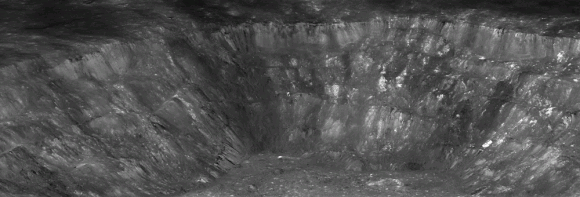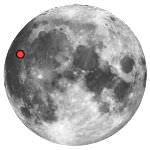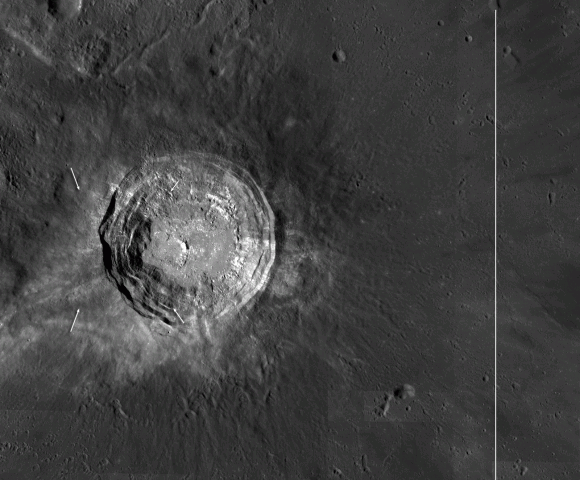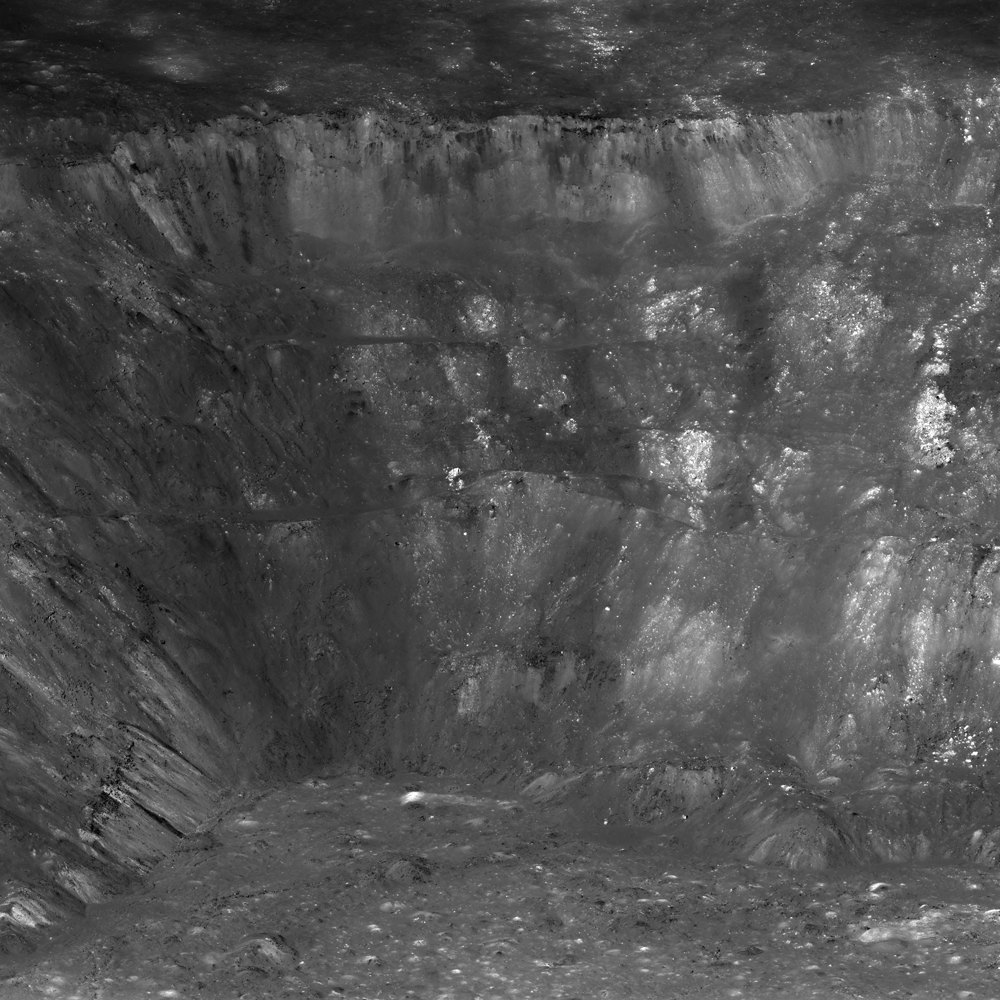[/caption]
Have you ever you looked up at the bright, cavernous Aristarchus Crater on the Moon through a telescope or binoculars and wondered what it would be like to stand on the rim and peer inside? Spectacular new views from the Lunar Reconnaissance Orbiter is almost as good as being there, and a new video lets you “rappel” down and take a closer look at the west side of the crater walls.

LRO Camera Principal Investigator Mark Robinson describes the region around the crater, known as the Aristarchus plateau, as one of the most geologically diverse places on the Moon. “A mysterious raised flat plateau, a giant rille carved by enormous outpourings of lava, fields of explosive volcanic ash, and all surrounded by massive flood basalts,” Robinson wrote on the LROC website. “A relatively recent asteroid (or comet) slammed into this geologic wonderland, blowing a giant hole in the ground revealing a cross section of over 3,000 meters (9,800 ft) of geology. No wonder planners for the Apollo missions put this plateau high on its list of targets for human exploration.”
These new amazing images were acquired on November 10, 2011 as LRO passed only 26 km (16.2 miles) above the surface, which is about two times lower than normal, due to LRO’s current elliptical orbit. The spacecraft was slewed to the west for an oblique or “sideways” look at the crater, instead of looking straight down as LRO normally does, to provide this unique perspective on Aristarchus. For a sense of scale, Robinson said that altitude is only a little over twice as high as commercial jets fly above the Earth. This crater is only one-tenth the size of Earth’s Grand Canyon, but the views from up above are similarly spectacular.

Aristarchus crater is located on the southeast edge of the Aristarchus Plateau. This yawning crater is 40 km wide and 3.5 km deep. The edges appear scalloped, almost like it crater was strip-mined. Since the crater is relatively young, Aristarchus is one of the brightest regions on the Moon. Robinson says these bright rocks may be anorthositic like the highlands, or they may be a more silicic rock like granite — or both.
“Although granites have been found in Apollo rock samples, the formation of granite on the Moon is not well understood at this time – another reason why we need to get samples from this region,” he said.

From this ‘straight down’ view, you can see the bright ejecta, contrasted by darker areas, which reflects the compositional difference between the various rocks in the region.
On the floor of Aristarchus crater is a wide variety of lunar rocks and geologic processes.
“Diverse materials such as dark, multilayered mare basalts in the walls, bright crustal rocks in the central peak, impact melt, and even regional pyroclastic materials blanketing the crater are brought to the floor and accumulated through mass wasting, creating a bountiful trove of geologic materials,” Robinson said.
Who’s ready to go exploring?!
Click here to see the full-resolution panoramic view of Aristarchus Crater.
Source: LROC
Hat tip and inspiration from Stu Atkinson


There appear to be layers of rock. I presume these are all basaltic type of rock; I would be flummixed if these turned out to be sedementary. The crater must have punched through layers from previous lava flows.
LC
Good guess, since the geological context is “enormous outpourings of lava, fields of explosive volcanic ash, and all surrounded by massive flood basalts [more lava]”.
The unspoken context here is that granites is the eutectic of basalts, i.e. the rather well defined composition that solidifies last and which the thermochemical balance strives for. (This is utilized in technologies as soldering, where the alloy is a eutectic to define a precise thermal melting point.)
This is thus the expected end result everywhere on silicate terrestrials of a process of basalt melting, solidifying and changing from an atmospheric and oceanic supply of volatiles and especially water. It is also of vital importance for plate tectonics, since granites are less dense than mantle basalts and hence form the plate floats.
However the specifics of granite formation has been a difficult and controversial subject:
“An old, and largely discounted theory, granitization states that granite is formed in place by extreme metasomatism by fluids bringing in elements e.g. potassium and removing others e.g. calcium to transform the metamorphic rock into a granite. This was supposed to occur across a migrating front. The production of granite by metamorphic heat is difficult, but is observed to occur in certain amphibolite and granulite terrains. In-situ granitisation or melting by metamorphism is difficult to recognise except where leucosome and melanosome textures are present in gneisses. […]
In all cases, melting of solid rock requires high temperature, and also water or other volatiles which act as a catalyst by lowering the solidus temperature of the rock.”
It is interesting that Granite has been found on the Moon. On a less nuts and bolts level, or should that be fine-grain detail:
GRANITE:
“Granite is the signature rock of the continents. More than that, granite is the signature rock of the planet Earth itself. The other rocky planets—Mercury, Venus and Mars—are covered with basalt, as is the ocean floor on Earth. But only Earth has this beautiful and interesting rock type in abundance.
“Three things distinguish granite.
“First, granite is made of large mineral grains (which is where its name came from) that fit tightly together.
“Second, granite always consists of the minerals quartz and feldspar, with or without a wide variety of other minerals (accessory minerals). The quartz and feldspar generally give granite a light color, ranging from pinkish to white. But that light background color is punctuated by the darker accessory minerals. ….
“Third, almost all granite is igneous (it solidified from a fluid state) and plutonic (it did so in a large, deeply buried body or pluton). The random arrangement of grains in granite—its lack of fabric—is evidence of its plutonic origin. ….
FORMATION:
“Granite is found in large plutons on the continents, in areas where the Earth’s crust has been deeply eroded. This makes sense, because granite must solidify very slowly at deeply buried locations to make such large mineral grains. Plutons smaller than 100 square kilometers in area are called stocks, and larger ones are called batholiths.
“Lavas erupt all over the Earth, but lava with the same composition as granite (rhyolite) only erupts on the continents. That means that granite must form by the melting of continental rocks, which happens for two reasons, adding heat and adding volatiles (water or carbon dioxide or both).
“Continents are relatively hot because they contain most of the planet’s uranium and potassium, which heat up their surroundings through radioactive decay. Anywhere that the crust is thickened tends to get hot inside (for instance in the Tibetan Plateau).
“And the processes of plate tectonics, mainly subduction, can cause basaltic magmas to rise underneath the continents. In addition to heat, these magmas release CO2 and water, which helps rocks of all kinds melt at lower temperatures. ….”
About.com: Geology —-> http://geology.about.com/od/more_igrocks/a/granite.htm
—————————————–
“Granite is the signature rock of the planet Earth itself.” And it has been found on Earth’s companion. May be significant to a long relationship that goes back to a single creation event: Both formed together from the beginning – inseparable.